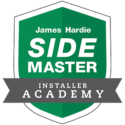Why settle for ordinary when you can elevate your home’s exterior with something extraordinary? Hardieplank siding has become the go-to choice for homeowners looking for durability coupled with classic charm. But what sets Hardieplank apart from other siding options, and why should it be on your radar for your next home improvement project? This blog dives into the essential details of Hardieplank siding, from its unique composition to its cost and installation considerations, helping you decide if it’s the right fit for your home.
What is Hardieplank?
Hardieplank, a product created by James Hardie, was introduced in the mid-1980s as a revolutionary alternative to traditional wood-based siding. Designed to withstand the harshest weather conditions, particularly in regions like St. Louis with its extreme temperature fluctuations, Hardieplank offers the appearance of wood siding without the common issues associated with wood, such as rot and extensive maintenance.
The composition of Hardieplank is what sets it apart. It’s made of a combination of Portland cement, silica, wood fibers, and water, along with some proprietary additives that enhance its durability and adaptability to various climates. Specifically, the product is engineered for two different climate zones in the United States, ensuring that homes in regions with freeze-thaw cycles, like St. Louis, have siding that can withstand these extreme conditions.
Pros of Hardieplank Siding
1. Durability:
Hardieplank is built to last. Unlike wood or vinyl siding, it doesn’t suffer from the same degree of expansion and contraction due to temperature changes. This means your siding stays firmly in place, even during heavy winds or extreme weather conditions.
2. Low Maintenance:
One of the significant advantages of Hardieplank is that it mimics the appearance of wood without the extensive upkeep. It resists mold, rot, and pests, which are common problems with traditional wood siding.
3. Climate Adaptability:
James Hardie engineers their siding to handle specific climate challenges. For example, in the northern regions of the U.S., where freeze-thaw cycles are common, the siding is equipped with additives that protect it from temperature-induced damage.
4. Moisture Management:
Hardieplank is designed with moisture management in mind. When installed correctly, it includes features like house wrap and flashing tape around windows and doors, ensuring a sealed system that protects your home from moisture intrusion.
5. Aesthetic Appeal:
With its wood-like appearance, Hardieplank adds a classic and timeless look to any home. It’s available in various colors and finishes, allowing homeowners to customize their home’s exterior to their liking.
Cons of Hardieplank Siding
1. Higher Installation Costs:
While Hardieplank itself isn’t significantly more expensive than other siding materials, the installation process requires a higher skill level. It’s essential to hire a contractor with experience in installing this type of siding, which can increase labor costs.
2. Heavier Material:
Hardieplank is heavier than other siding options like vinyl, which can make the installation process more labor-intensive and time-consuming. This weight also means it requires a more robust structure to support it.
Costs of Hardieplank Siding
When considering the cost of Hardieplank siding, it’s essential to look beyond the initial price tag of the material itself. The total cost includes the product, installation, and any additional materials required for proper installation, such as house wrap, flashing tape, and fasteners.
1. Material Costs:
Hardieplank typically costs slightly more than vinyl siding but offers superior durability and aesthetic appeal. On average, you can expect to pay between $7 to $13 per square foot for materials.
2. Installation Costs:
Due to the complexity of installation, labor costs for Hardieplank siding are higher than for other materials. Skilled craftsmen are required to ensure the siding is installed correctly, preventing issues down the road. Installation costs can range from $3 to $10 per square foot, depending on your location and the complexity of the job.
3. Return on Investment:
Despite the higher upfront costs, Hardieplank offers one of the highest returns on investment among siding options. Its durability means fewer repairs and replacements over time, and its aesthetic appeal can increase your home’s value, making it a wise long-term investment.
In Summary
Choosing the right siding for your home is a significant decision, and Hardieplank offers numerous benefits that make it an excellent choice for homeowners looking for durability, low maintenance, and aesthetic appeal. While the initial costs may be higher, the long-term benefits, including a high return on investment, make Hardieplank a worthy consideration for your next home improvement project.
If you’re interested in learning more or need expert installation services, contact us today. We’re here to help you protect and beautify your home.














